Resources
Harness Responsible and Beneficial AI for Fundraising
Access our curated list of Responsible and Beneficial AI and Fundraising resources below
2023 Summit Sessions

Welcome & Opening Remarks
Mallory Erickson, Power Partners Formula™ and Host, What The Fundraising
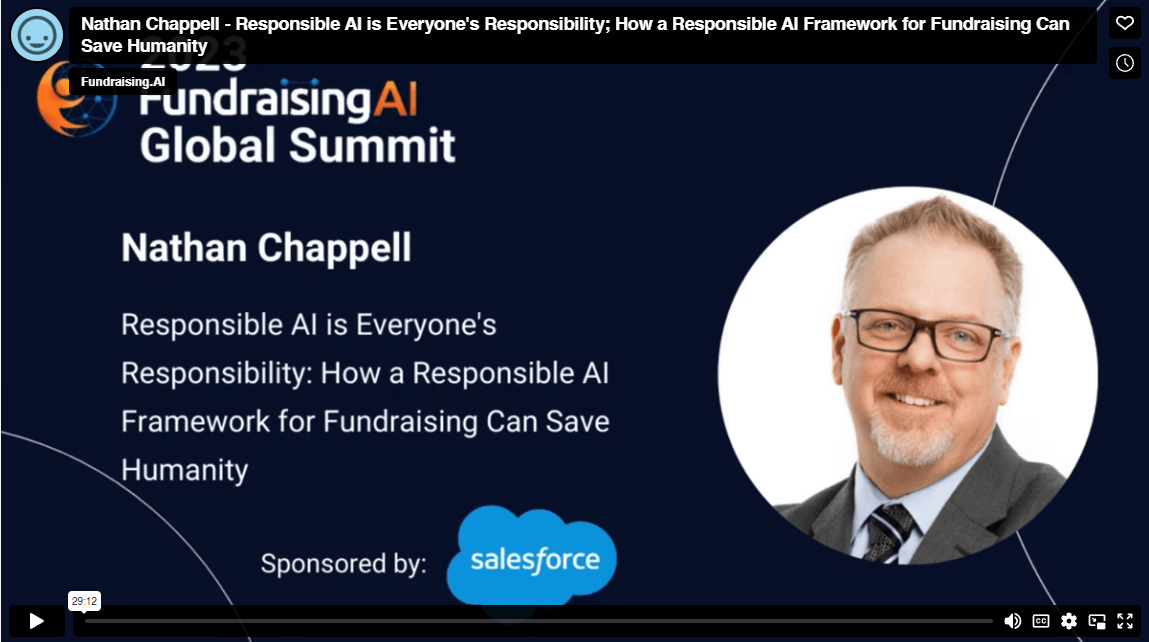
Responsible AI is Everyone's Responsibility: How a Responsible AI Framework for Fundraising Can Save Humanity
29:12
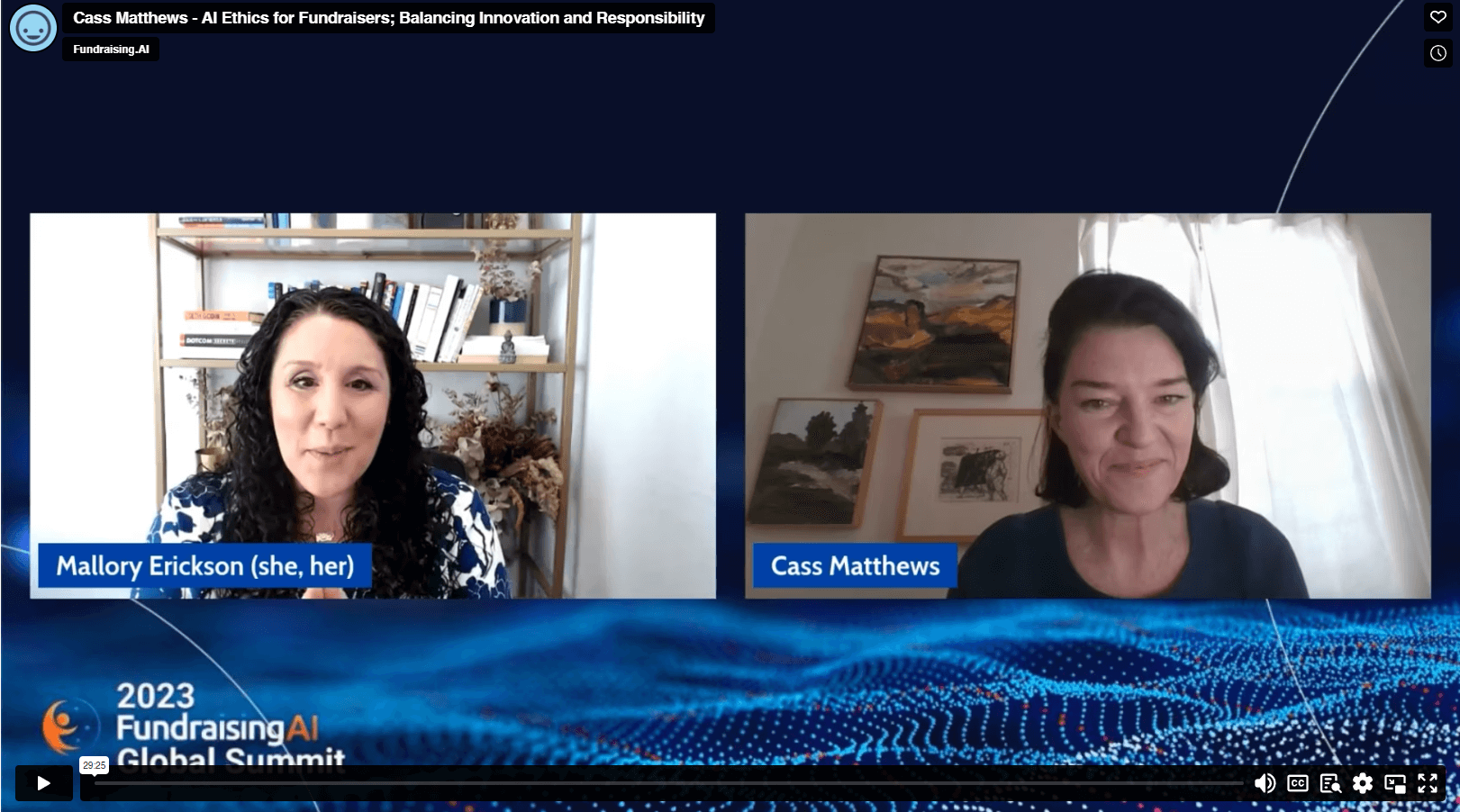
AI Ethics for Fundraisers: Balancing Innovation and Responsibility

AI 101 to Enhance Impact
31:31

When it comes to AI, what makes us successful?: Practical steps to evaluating AI and AI vendors
30:16

Panel: The Power of Big Data and How Data Can Inform Strategic Business Decisions
ft. Bloomerang, Neon One, DonorPerfect, Virtuous, and Mallory Erickson
29:12

Striking the Balance: AI Efficiency and Donor Trust
Rebekah Tweed, All Tech is Human
28:46

AI and Personalization: Building Stronger Human Relationships
30:48
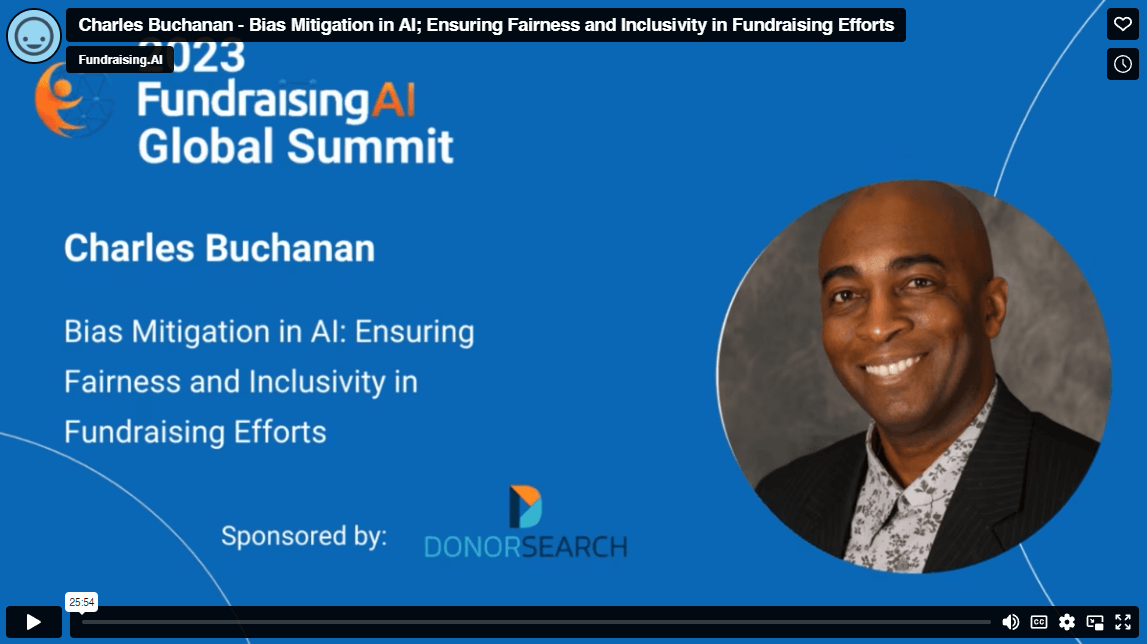
Bias Mitigation in AI: Ensuring Fairness and Inclusivity in Fundraising Efforts
Charles Buchanan, Technology Helps
25:52
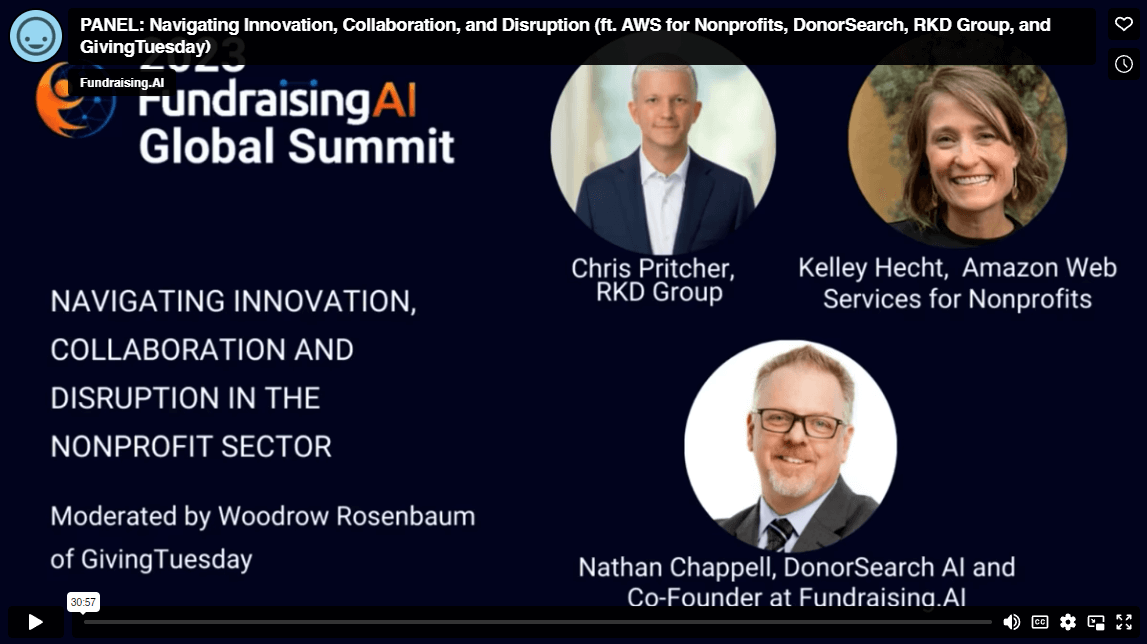
Panel: Navigating Innovation, Collaboration and Disruption in the Nonprofit Sector
30:57

Generative AI & Modern Innovation: Responsible & Ethical AI Integration
22:07

Accelerating the AI Adoption Curve - From Hesitation to Empowerment
Nejeed Kassam, Keela
30:00
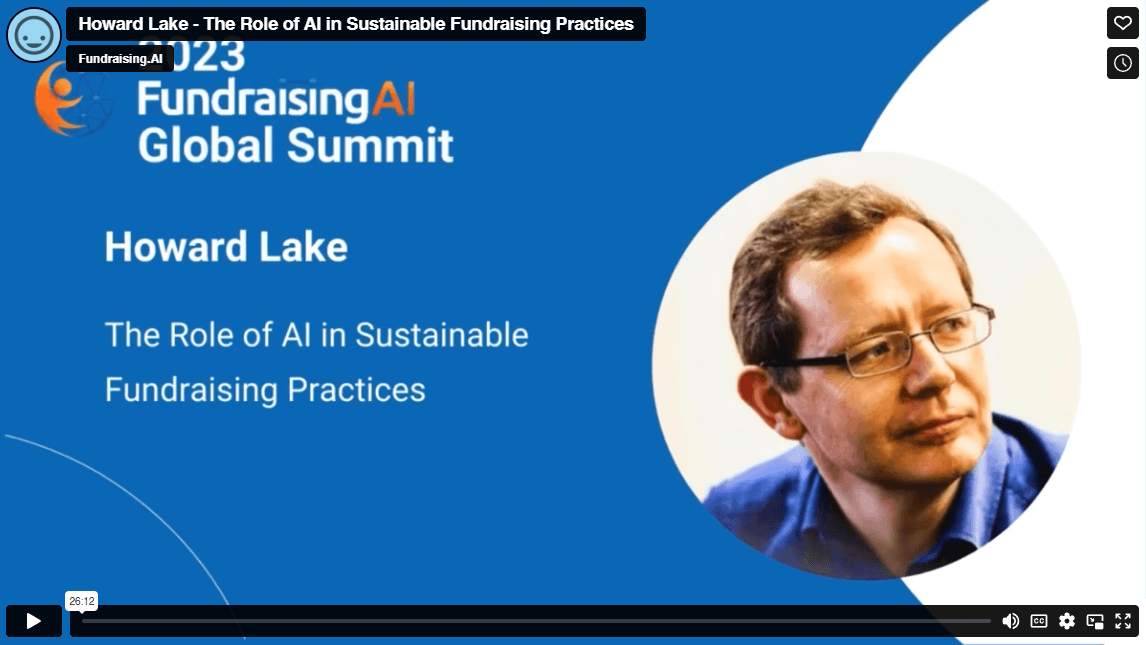
The Role of AI in Sustainable Fundraising Practices
Howard Lake, UK Fundraising
26:10
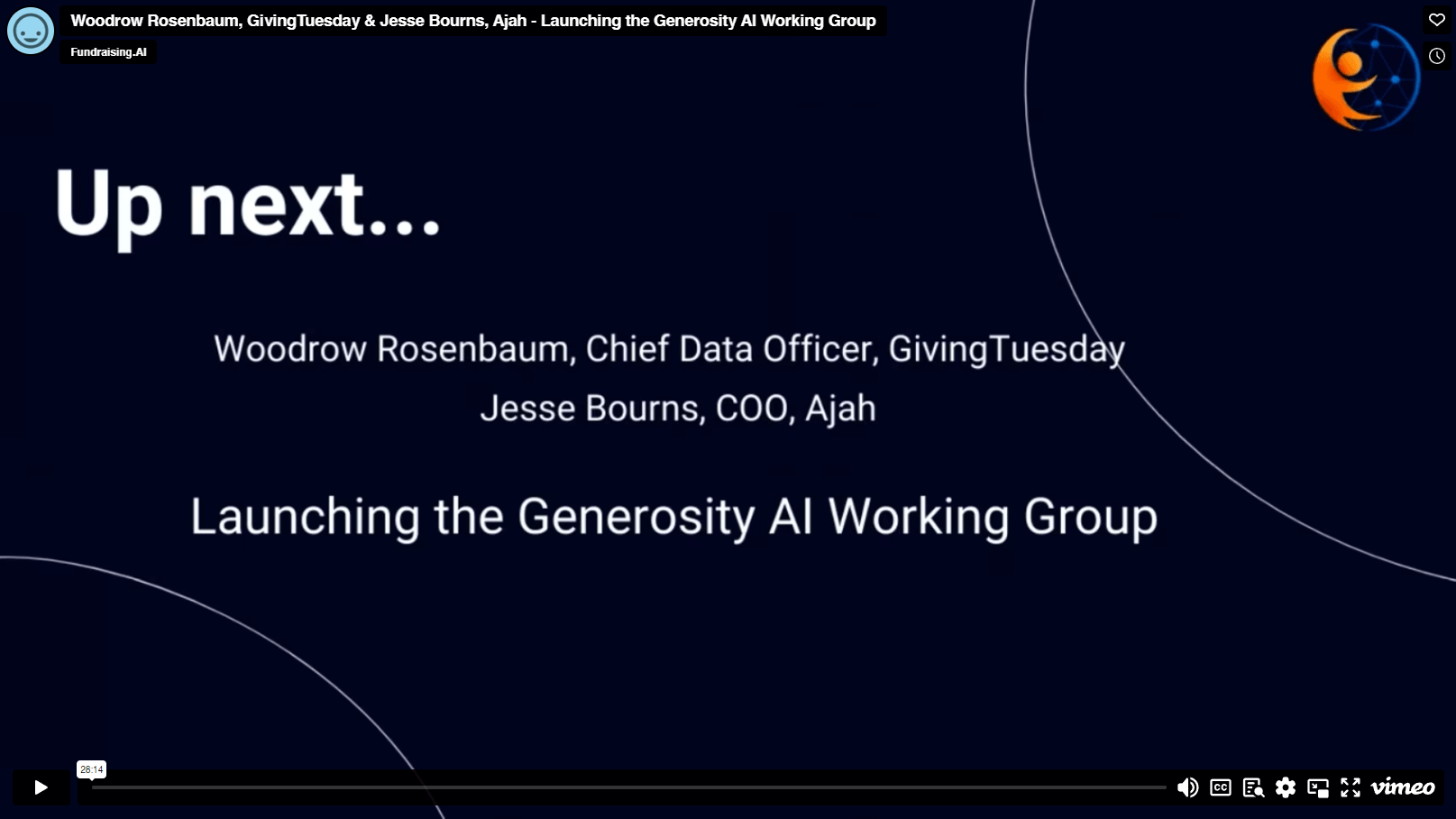
Launching the Generosity AI Working Group
Woodrow Rosenbaum, GivingTuesday & Jesse Bourns, Ajah
28:14
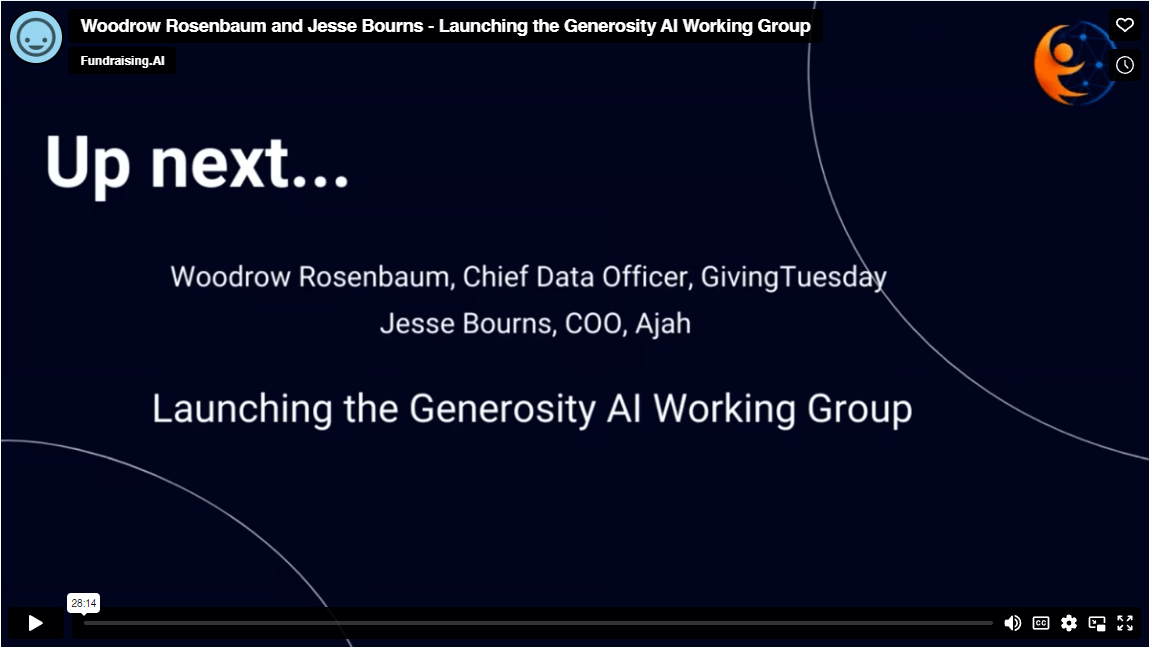
Privacy & Security in AI Systems: Protecting Donor Information in the Age of AI
Ken Haigh, Omatic Software
28:14
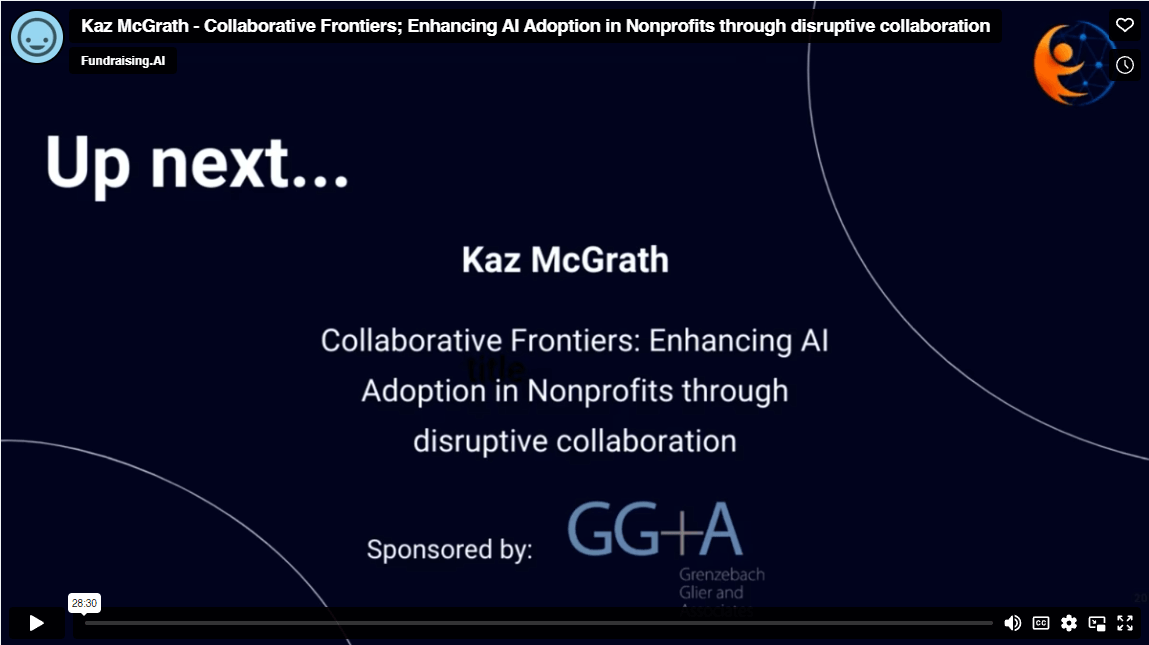
Collaborative Frontiers: Enhancing AI Adoption in Nonprofits through disruptive collaboration
Kaz McGrath, Plai and Starling
28:30
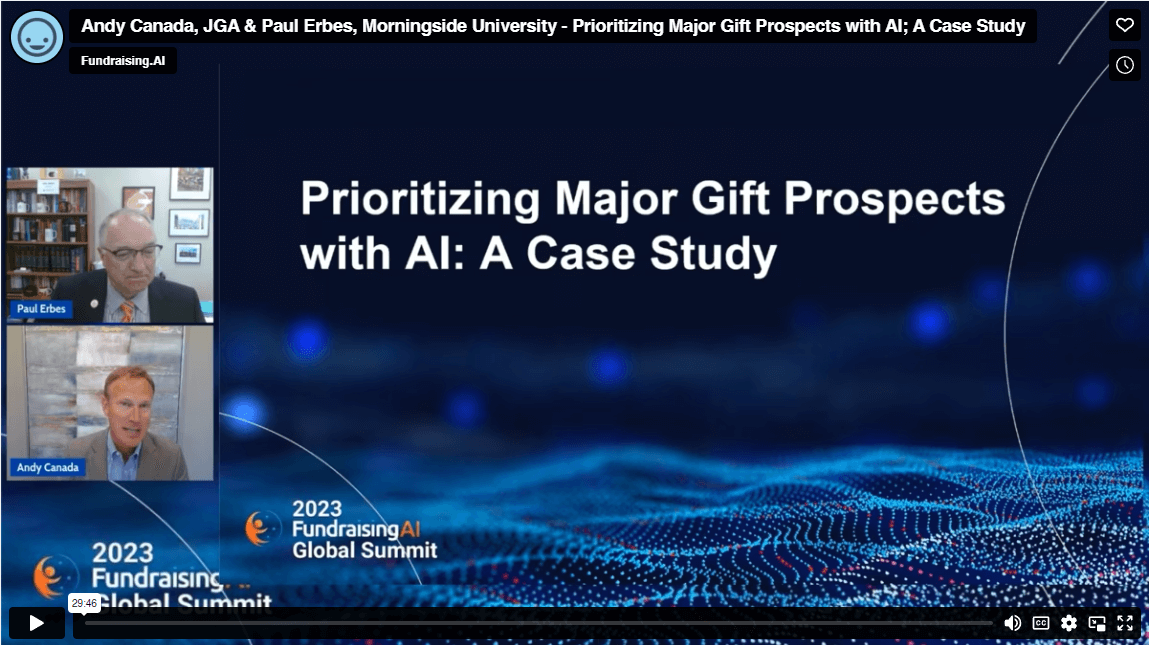
Prioritizing Major Gift Prospects with AI: A Case Study
Andy Canada, JGA & Paul Erbes, Morningside University
28:14

Voices from the Field: Boost Your Productivity and Impact with AI
Devi Thomas, Microsoft Philanthropies & Alex Kasavin, Tech for Social Impact, Microsoft
29:57
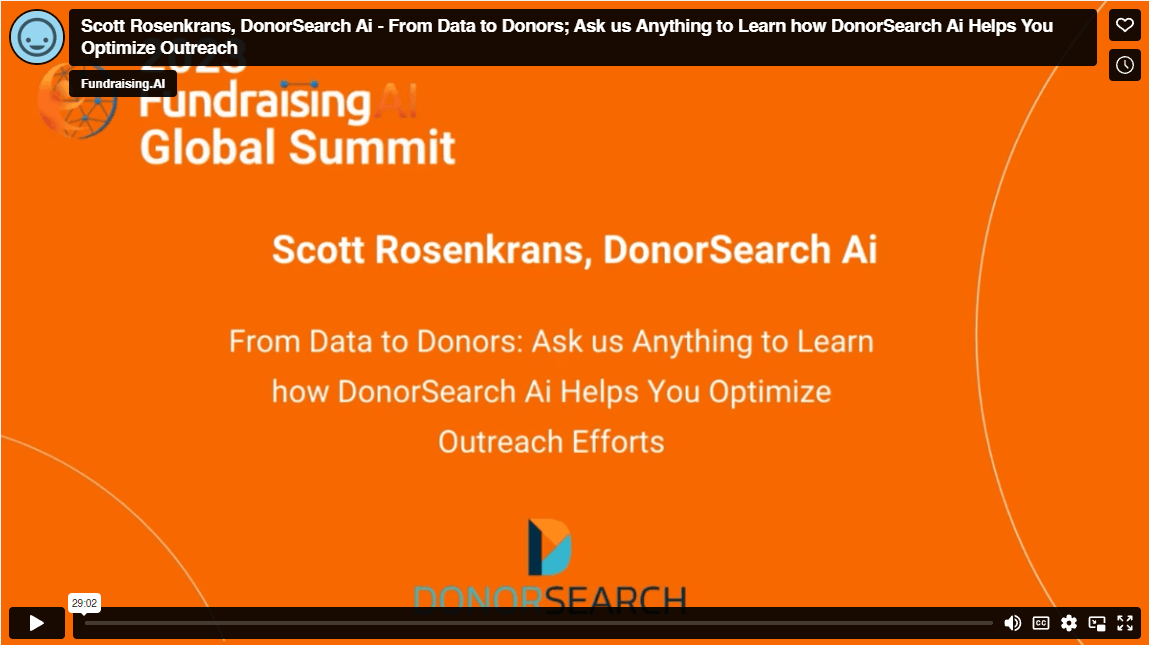
From Data to Donors: Ask us Anything to Learn how DonorSearch Ai Helps You Optimize Outreach Efforts
Scott Rosenkrans, DonorSearch Ai
29:02

Fundraising Intelligence AMA
Nundini Krishnan & Mary Whitrow, iWave
29:46
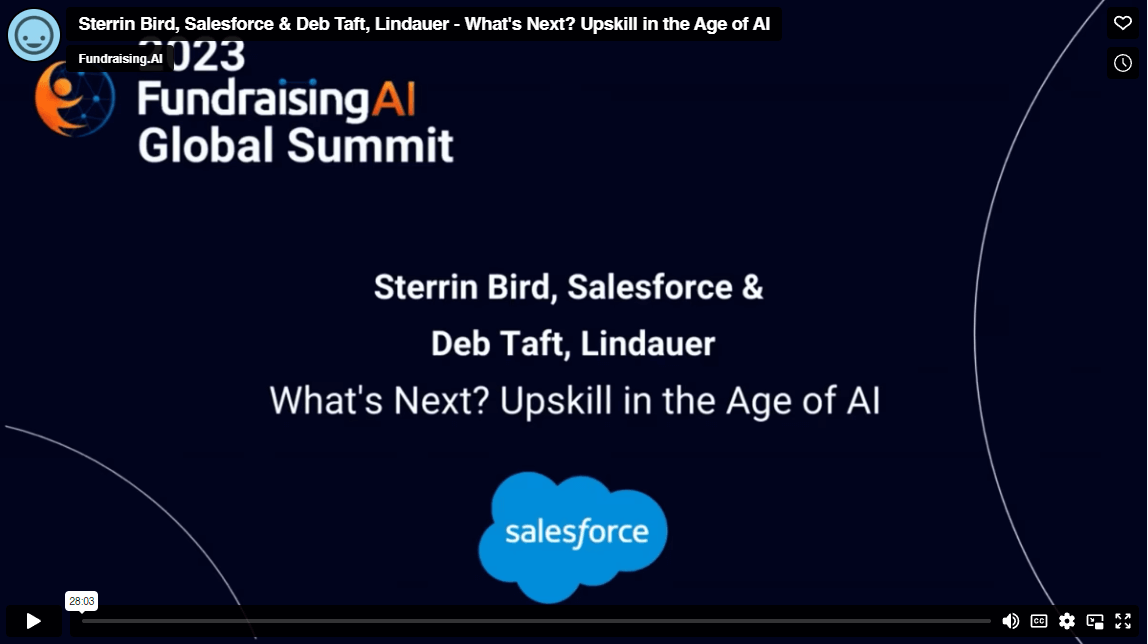
What's Next? Upskill in the Age of AI
Sterrin Bird, Salesforce & Deb Taft, Lindauer
28:03

Leveraging Consumer Data using AI and Machine Learning in a Privacy Responsible Way
Roger Hiyama & Cameron Popp, Wiland
30:44

Can we talk about trust?
Justin McCord & Amanda Wasson, RKD Group
29:12
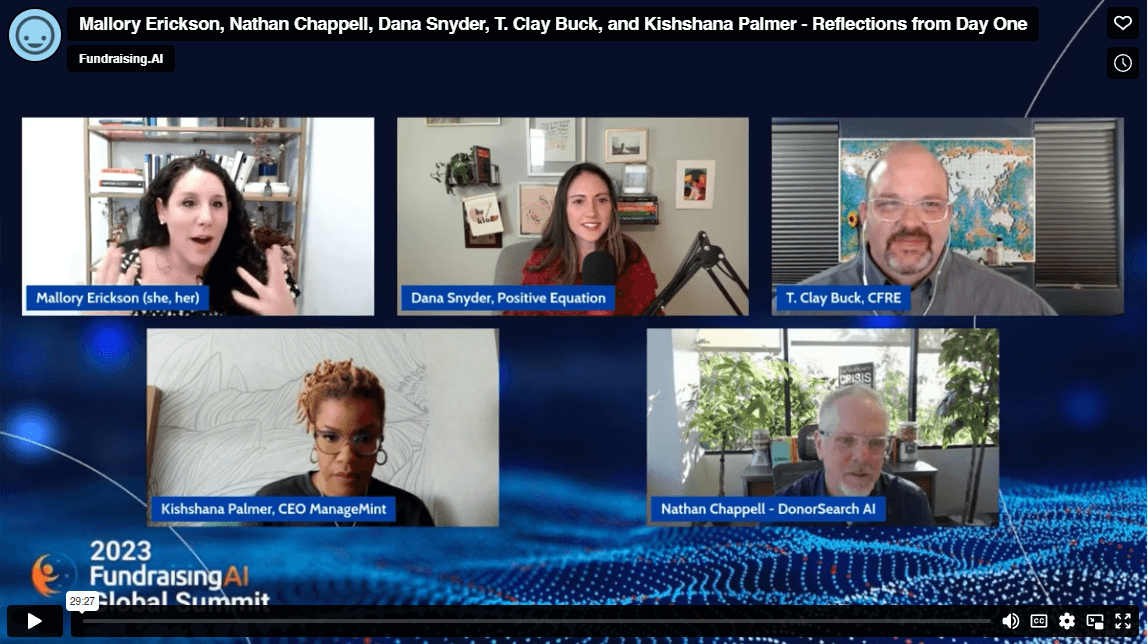
Reflections from Day One
29:27
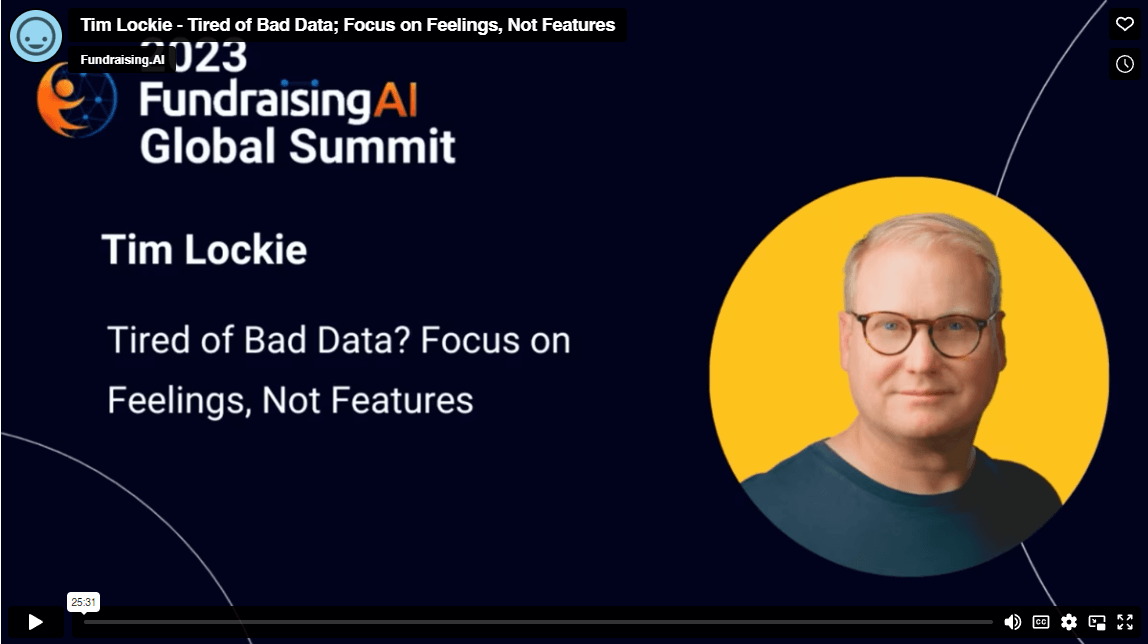
Tired of Bad Data? Focus on Feelings, Not Features
Tim Lockie, The Human Stack
25:31
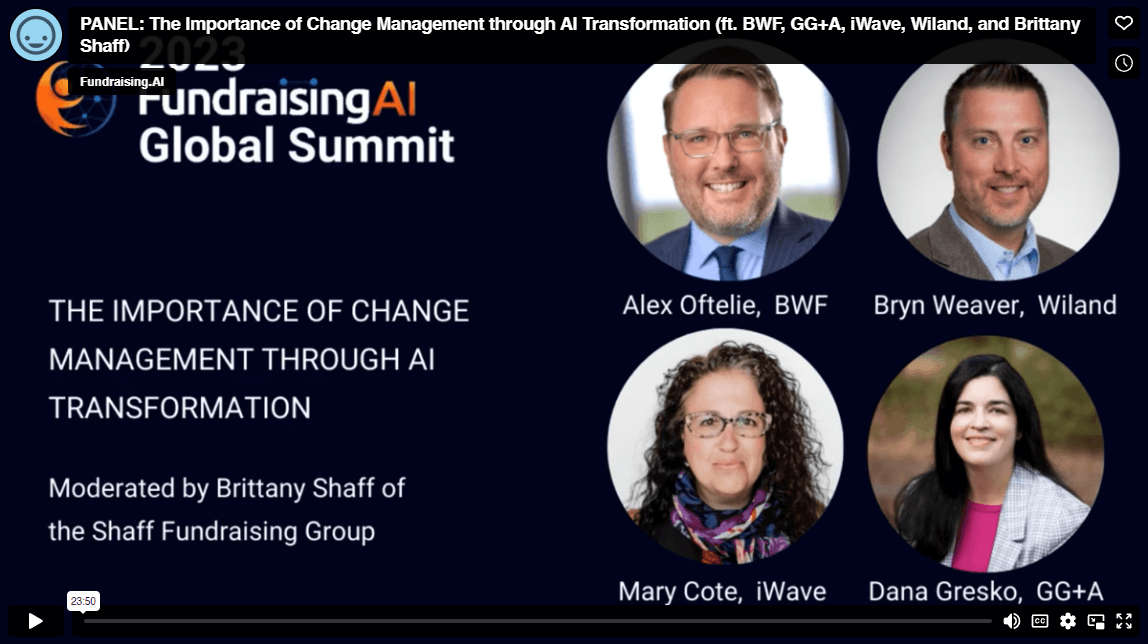
Panel: The Importance of Change Management through AI Transformation
ft. BWF, GG+A, iWave, Wiland, and Brittany Shaff
23:50
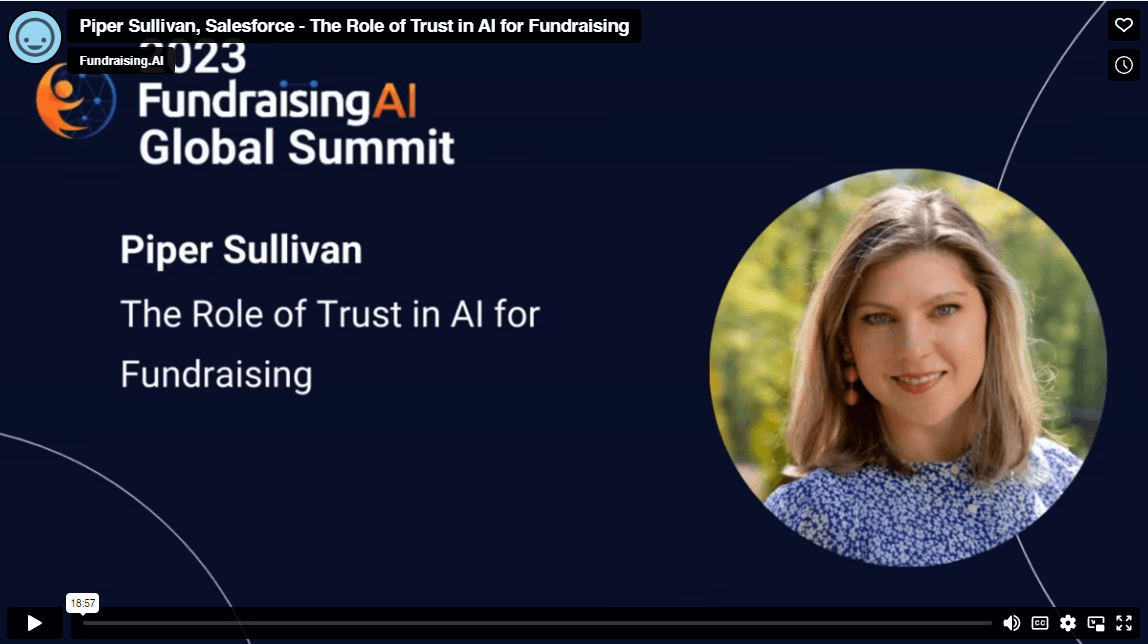
The Role of Trust in AI for Fundraising
Piper Sullivan, Salesforce
18:57

Jobs and AI: Roles, Responsibilities & Employee Wellbeing
Liji Thomas, Valorem Reply
29:26
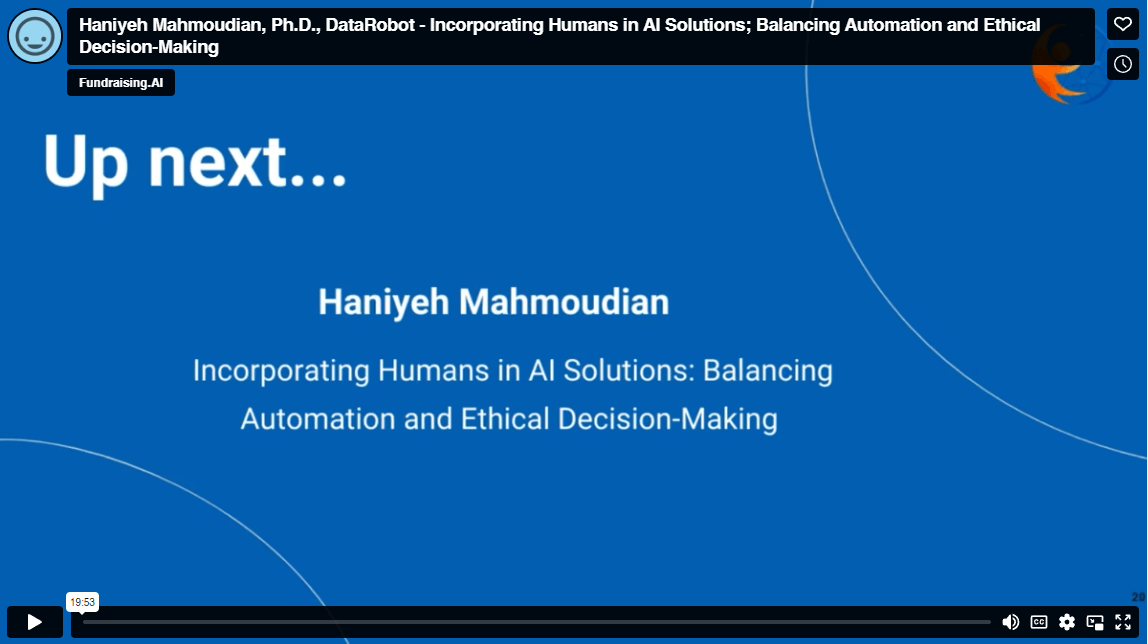
Incorporating Humans in AI Solutions: Balancing Automation and Ethical Decision-Making
Haniyeh Mahmoudian, Ph.D., DataRobot
19:53
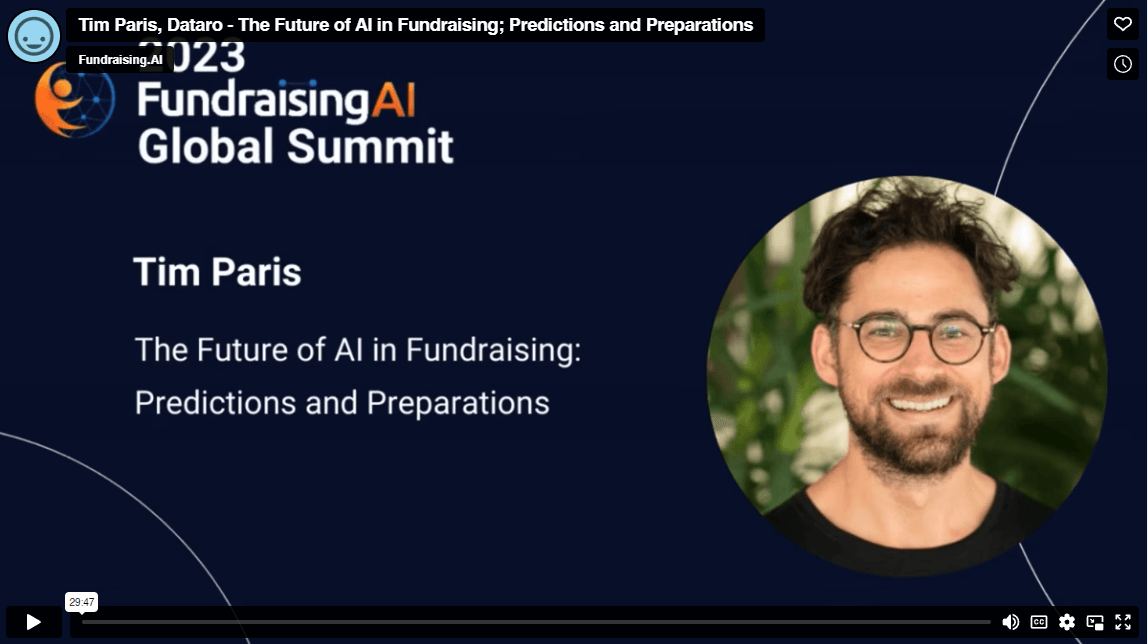
The Future of AI in Fundraising: Predictions and Preparations
Tim Paris, Dataro
29:47
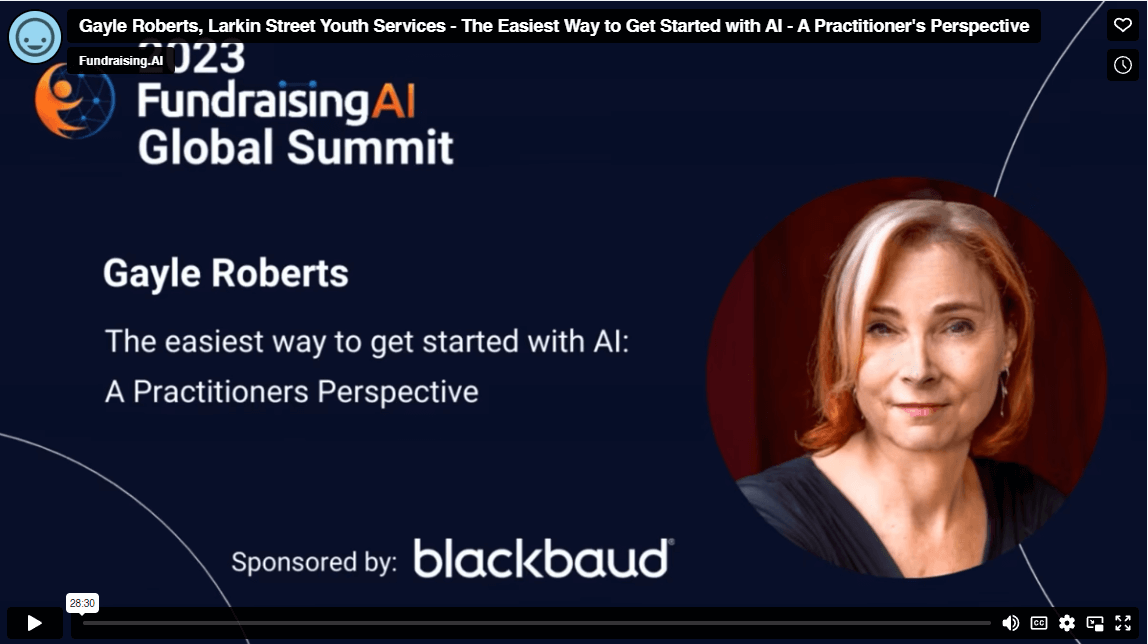
The Easiest Way to Get Started with AI - A Practitioner's Perspective
Gayle Roberts, Larkin Street Youth Services
28:30
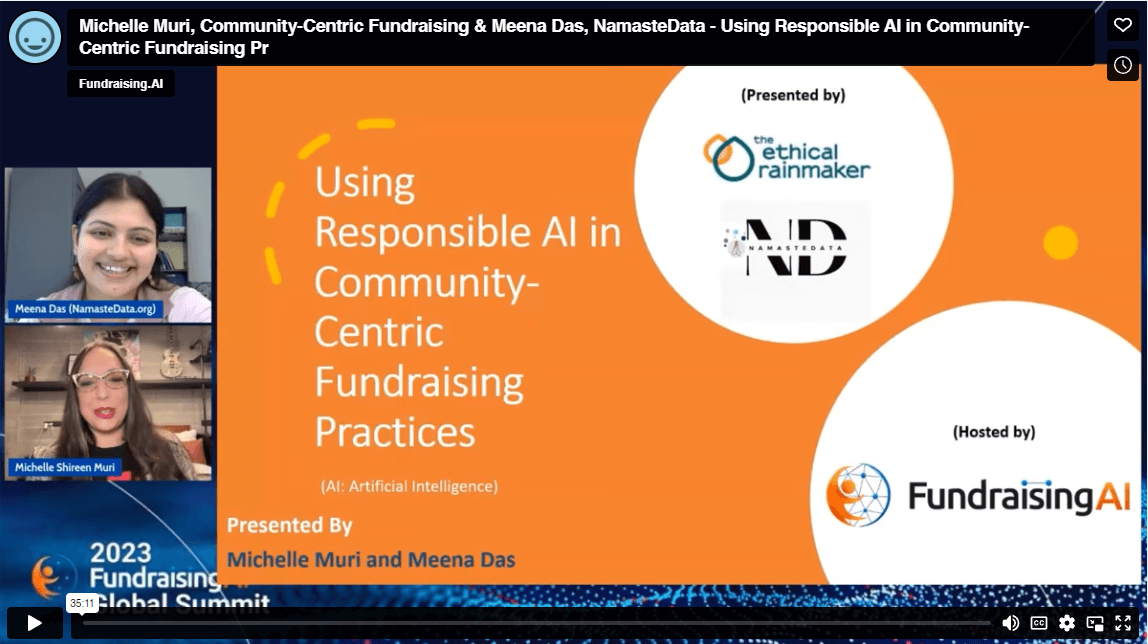
Using Responsible and Beneficial AI in Community-Centric Fundraising Practices
35:11

Panel: Building a Trustworthy Ecosystem: The Responsible and Beneficial AI for Fundraising Imperative
ft. Salesforce, Microsoft, Blackbaud, and Amazon Web Services (AWS) for Nonprofits
46:37
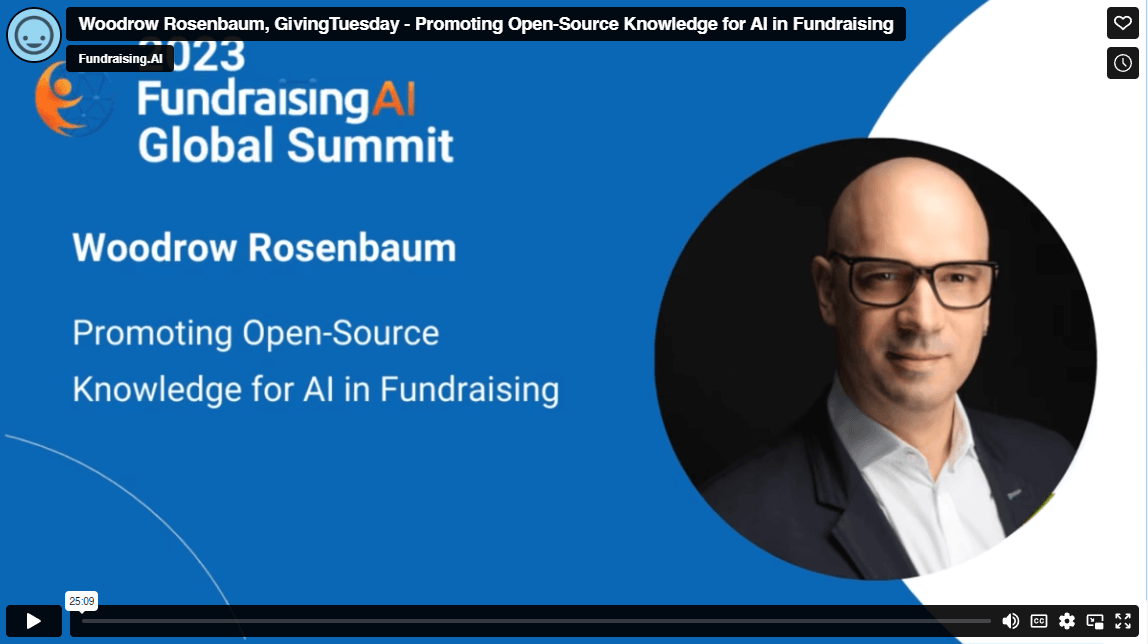
Promoting Open-Source Knowledge for AI in Fundraising
Woodrow Rosenbaum, GivingTuesday
25:09
- 0
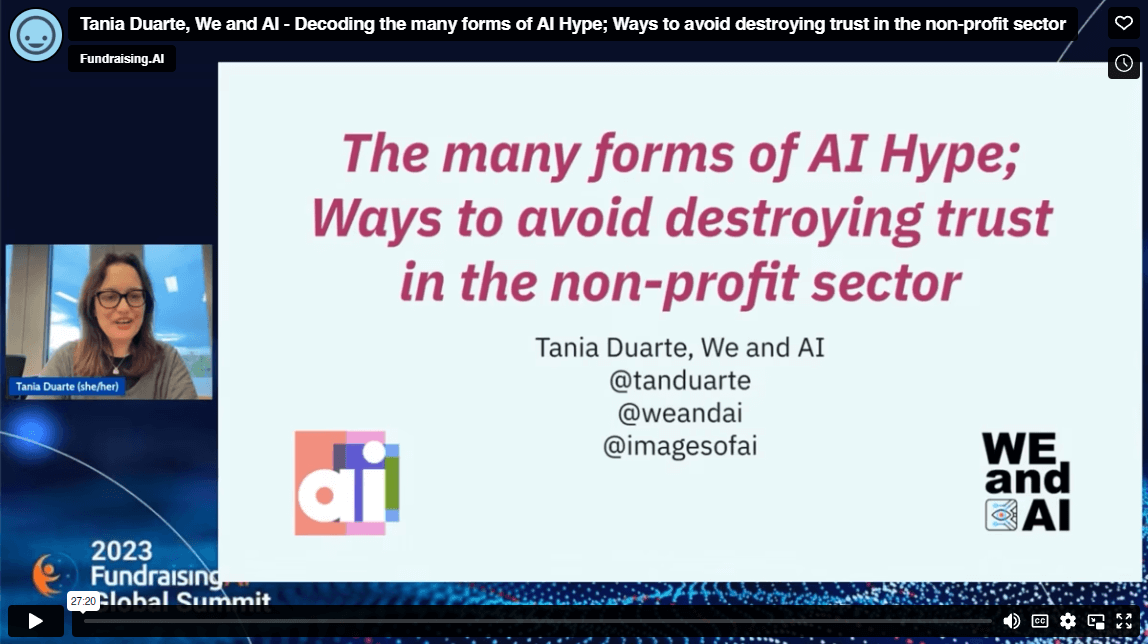
Decoding the many forms of AI Hype; Ways to avoid destroying trust in the non-profit sector
Tania Duarte, We and AI
27:20

AI Governance and Navigating the Regulatory Landscape for AI in Fundraising
26:29
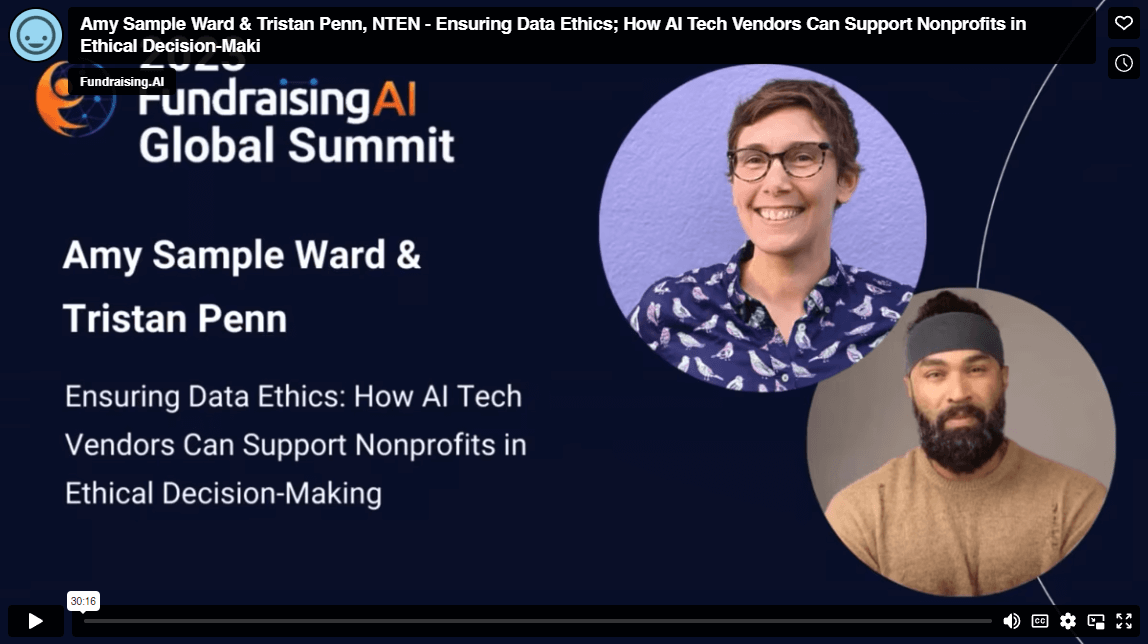
Ensuring Data Ethics: How AI Tech Vendors Can Support Nonprofits in Ethical Decision-Making
Amy Sample Ward & Tristan Penn, NTEN
30:16

Data Ethics & Transparency: Building Trustworthy AI Systems for Fundraising
Stefan Byrd-Krueger, ParsonsTKO
30:20

AI as a Tool for Equity
29:26
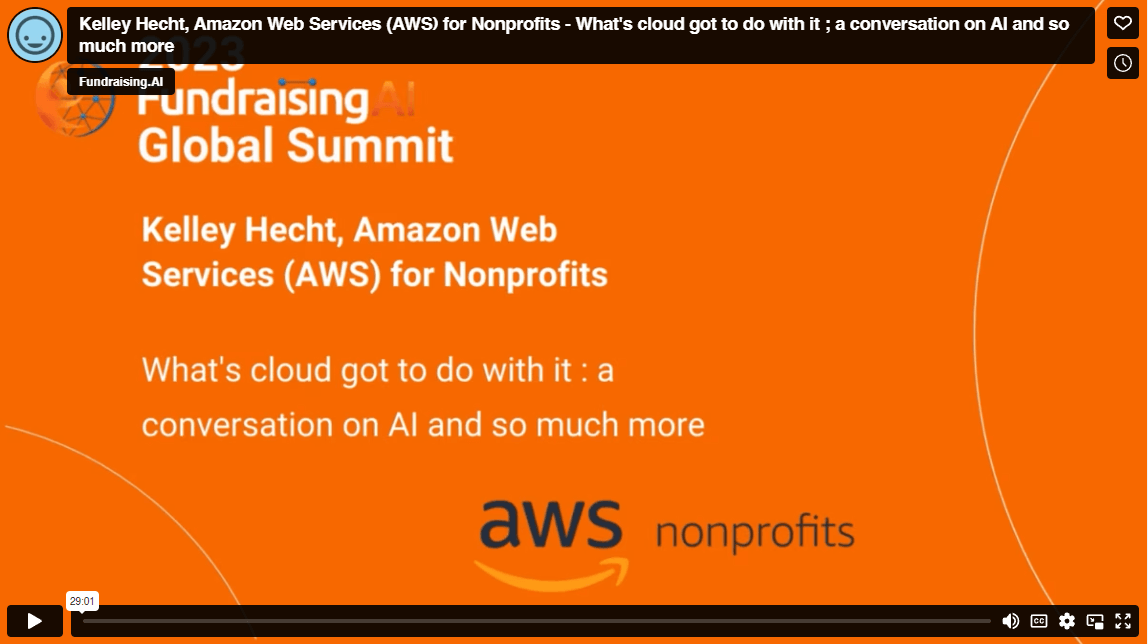
What's cloud got to do with it : a conversation on AI and so much more
Kelley Hecht, Amazon Web Services (AWS) for Nonprofits
29:01
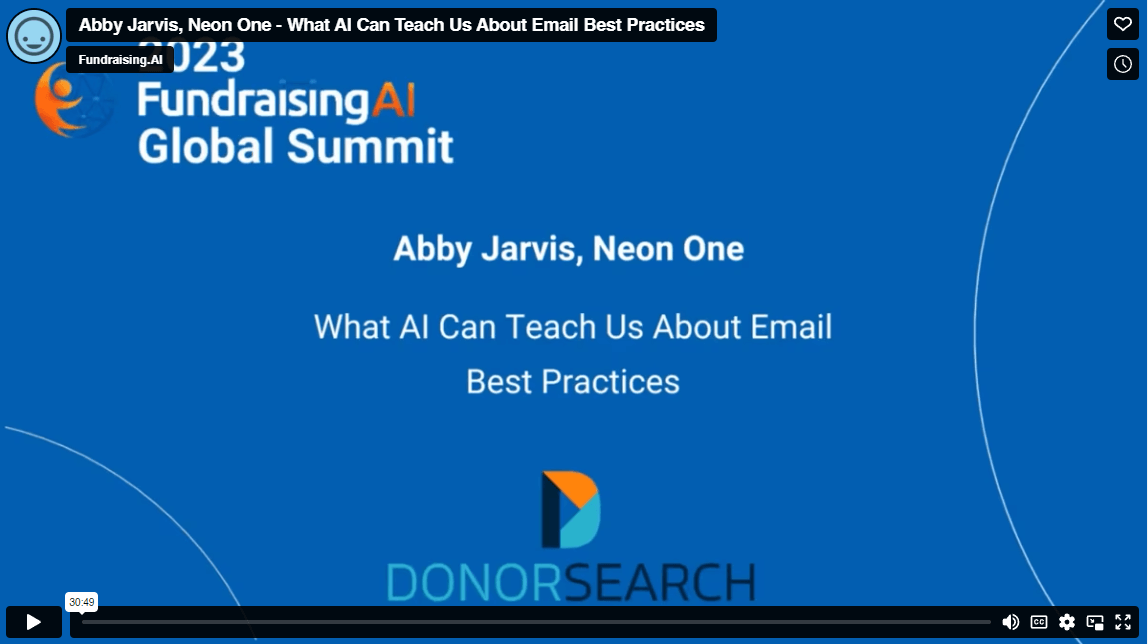
What AI Can Teach Us About Email Best Practices
Abby Jarvis, Neon One
30:49
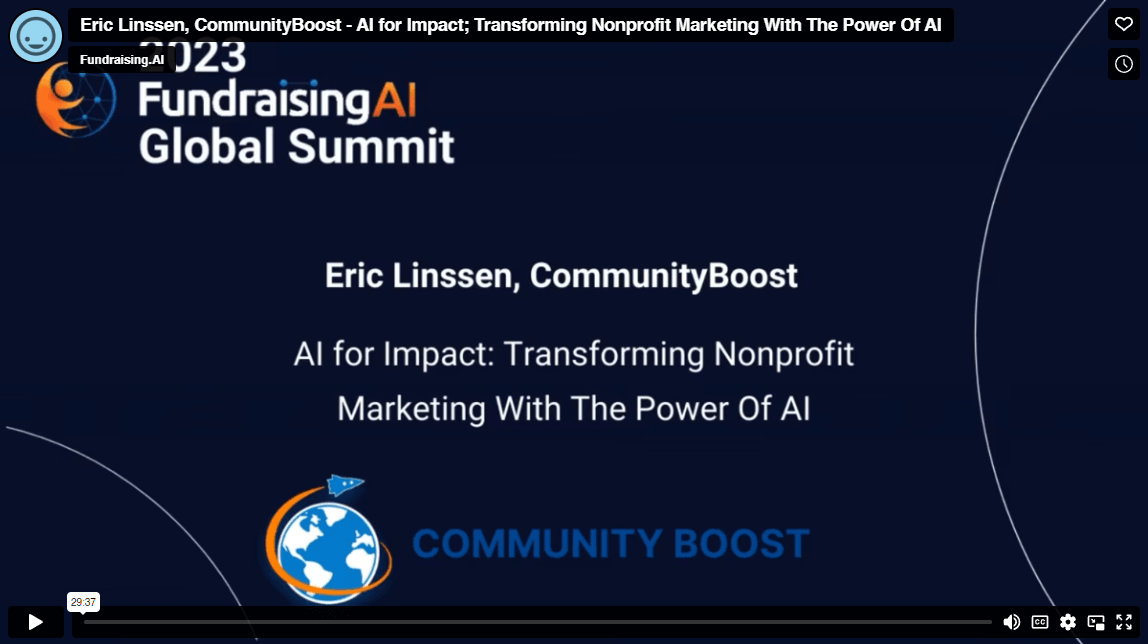
AI for Impact: Transforming Nonprofit Marketing With The Power Of AI
Eric Linssen, CommunityBoost
29:37
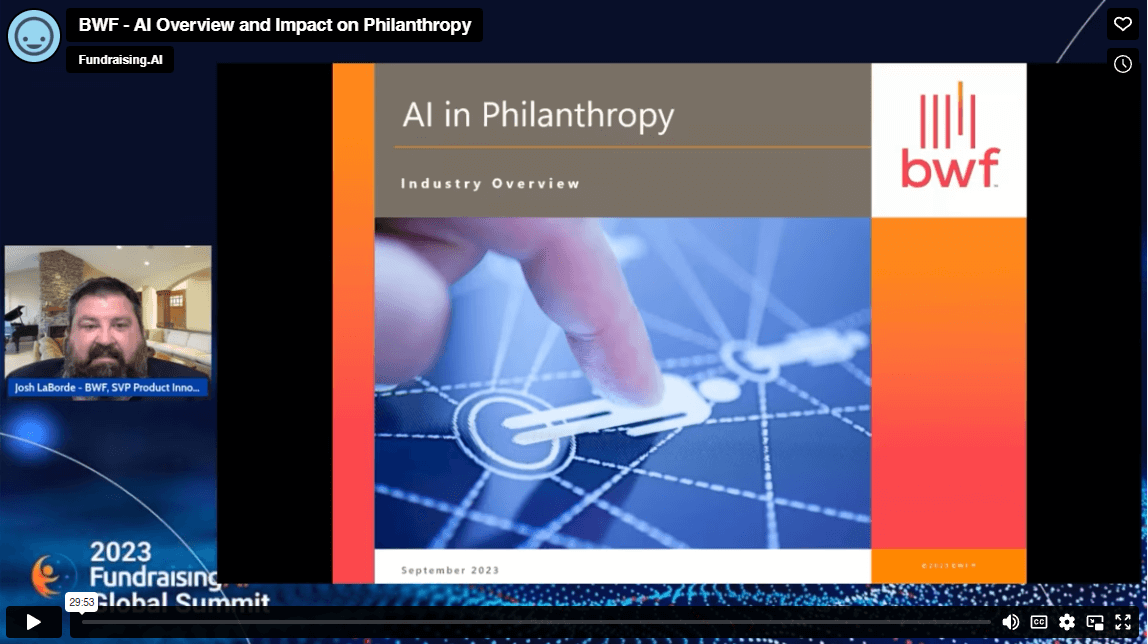
AI Overview and Impact on Philanthropy
Joshua LaBorde, BWF
29:53
AI Resources
How to Spot Responsible and Beneficial AI: Three Questions to Start With
Your AI tools should be as responsible to your cause, donors, and team as you are. In this new tip sheet from Blackbaud, learn how to quickly spot the signs of Responsible and Beneficial AI and the principles behind them so you can make informed decisions when adopting new tools.
Everything You Need to Know About AI for Nonprofits
Explore the E-Guide to learn how AI can empower you to:
- Increase Fundraising Revenue
- Find and Solicit High-Capacity
- Prospects Most Likely to Give Streamline Fundraising Operations

Unlocking the Power of AI for Ethical Nonprofit Fundraising
Explore our dedicated page focusing on the ethical considerations concerning the integration of Artificial Intelligence (AI) in nonprofit fundraising. In an era marked by the AI revolution, the nonprofit sector is keen to leverage AI’s immense potential to advance their missions. Yet, before delving into this dynamic landscape, it is imperative to carefully navigate the ethical dimensions. In the following blog post, we will delve into the seven ethical factors that nonprofit leaders should consider when adopting AI for fundraising.
5 minute assessment of your organizations digital mindset
Take our five-minute cloud maturity assessment to:
- Benchmark your organization’s stage of cloud adoption against the overall nonprofit sector;
- Get a high-level overview of your organization’s cloud adoption stage and its implications; and
- Receive tailored recommendations and resources to help you plan your next steps.

Chart Your Course: Navigating the New AI Landscape
Looking for more resources on how AI can become a part of your work? Check out the Chart Your Course: Navigating the New AI Landscape webinar series from the Blackbaud Institute, with expert insights into everything from strategic planning around innovation; privacy and ethics; creating your own low-code apps; to the fundamentals of how AI can power your fundraising.
DonorSearch Ai - How We Can Help You With Specific Fundraising Initiatives
DonorSearch Ai is the most advanced machine learning algorithm ever developed for the nonprofit sector. By enriching your data with more than 800 additional data points, DonorSearch Ai uses proprietary AI algorithms to recognize intricate patterns, process more information, and make specific recommendations on which prospects are most likely to make a gift within a rolling 12-month period.

Understand your organizations digital mindset
Download the Powering purpose in the cloud: A guide for cloud adoption in the nonprofit sector to learn about:
- Technology trends and the state of cloud adoption in the nonprofit sector
- Three distinctive mindsets in cloud adoption and practical implications for each
- Key cloud use cases for each mindset and case studies of nonprofit organizations that are deploying cloud technology with purpose

Fundraising Resources
Building a Data Management Strategy for Your Nonprofit
Fewer than 25% of nonprofits report having a data management plan in place. This means data is rarely used to make decisions or predict behaviors.
In this white paper, learn how to build a data management strategy so you can:
- Make better decisions with data analysis and visualizations
- Create more intelligent and compelling campaigns using predictive insights
- Improve operational efficiency by streamlining business workflows – Put trust at the center of your mission by securing stakeholder data

Donor-Centric Fundraising Guide
Maximize your fundraising efforts by putting donors at the center. In this guide, learn how technology can more effectively meet the needs — and rising expectations — of donors.
Realize fundraising success now with key learnings around each aspect of the donor experience, including:
- Awareness
- Trust
- Connectedness
- Ownership
- Promotion

Nonprofit Trends Report
Discover how nonprofit leaders are using technology to improve their organization’s efficiency — and results! The Nonprofit Trends Report, now in its fifth annual edition, distills input from over 1,600 nonprofit professionals into insights to help your organization succeed now. Meet your mission more effectively by exploring:
- The challenges, priorities, and opportunities in the sector
- What nonprofits expect in the year ahead – Surprising ways digital maturity impacts employee engagement
- Key learnings for DEI and sustainability

Ready to make technology work for your mission?
Microsoft Tech for Social Impact is committed to delivering affordable and innovative cloud solutions to help nonprofits tackle the world’s biggest challenges.
- To access grants and discounts across our cloud products, visit: aka.ms/nonprofits.
- To participate in our comprehensive training programs and accelerate your AI skills, visit us at aka.ms/nonprofit-AI-skills.
Crash Course in Fundraising and Engagement
Crash Course in Fundraising and Engagement provides key tips and tricks for how you can:
- Connect with donors digitally
- Personalize the donor experience even more
- Respond to urgent fundraising needs
- Evaluate fundraising efforts in real-time and make changes as needed
- Be as efficient as possible with donor dollars
- Demonstrate impact on an ongoing basis
Request an introduction to your Account Executive
Chat live, call, or complete the form below to reach an Amazon Web Services (AWS) nonprofit business representative. You’ll hear back from us within one business day to discuss how AWS can help your organization.

Solid Gold: The Nonprofit Marketers Guide to Trust
RKD’s research on what donors identify creates or deteriorates trust with nonprofits.
Group Thinkers
RKD’s Group Thinkers podcast is an award-winning long-form conversation podcast with industry experts.
Fundraising in a Recession: 7 Strategies to Raise More Money
In times of economic uncertainty, nonprofits find themselves facing many challenges. However, it’s important to remember that donors will always donate! The key lies in adapting fundraising strategies to the evolving landscape and leveraging new fundraising opportunities. In this ebook, you’ll learn:
- Strategies to raise more money during economic uncertainty
- How to segment your database
- How to expand your networks
- How to diversify fundraising sources

Fundraising Intelligence Resources
Visit our “Conferences” webpage to access more Fundraising Intelligence and iWave resources!

Fundraiser’s Field Guide to Donor Optimization
Fundraisers today are being asked to do more with less, whether the skies are clear or the terrain is rocky. The key to success lies within the most powerful resource a nonprofit has—its donor relationships. Because when fundraisers fully understand their donors and use that data to optimize their fundraising efforts, they can maximize sustainable revenue growth. That’s why Wiland has created The Fundraiser’s Field Guide to Donor Optimization—to help nonprofits determine their next steps on their path to peak donor optimization. This guide outlines the must-have tools and best practices nonprofits need to maximize campaign effectiveness.

The Nonprofit Email Report: Data-Backed Insights for GivingTuesday and Year-End
How many emails should you send on GivingTuesday? Do donors really read your year-end fundraising emails, or do they tune them out? Which day is the best for sending annual appeals? And what can artificial intelligence teach us about being more human in our emails?
Find out today! When you download this extension of The Nonprofit Email Report: Data-Backed Insights for Better Engagement, you’ll uncover:
- Answers to common questions about end-of-year fundraising emails
- Email performance benchmarks for campaigns sent on GivingTuesday and the last three days of the year
- Takeaways specifically for both large and small organizations
This guide will be a valuable companion as you hone your GivingTuesday and end-of-year communication strategies—grab your copy today!
Steering Committee
Artificial Intelligence (AI) Terms: A to Z Glossary
AI (artificial intelligence)
AI stands for artificial intelligence, which is the simulation of human intelligence processes by machines or computer systems. AI can mimic human capabilities such as communication, learning, and decision-making.
AI ethics
AI ethics refers to the issues that AI stakeholders such as engineers and government officials must consider to ensure that the technology is developed and used responsibly. This means adopting and implementing systems that support a safe, secure, unbiased, and environmentally friendly approach to artificial intelligence.
Algorithm
An algorithm is a sequence of rules given to an AI machine to perform a task or solve a problem. Common algorithms include classification, regression, and clustering.
Application programming interface (API)
An API, or application programming interface, is a set of protocols that determine how two software applications will interact with each other. APIs tend to be written in programming languages such as C++ or JavaScript.
Beneficial AI
Beneficial AI (BAI) aims to ensure that AI technologies not only meet ethical standards but also actively contribute to human welfare and societal well-being, delivering tangible positive outcomes.
Big data
Big data refers to the large data sets that can be studied to reveal patterns and trends to support business decisions. It’s called “big” data because organizations can now gather massive amounts of complex data using data collection tools and systems. Big data can be collected very quickly and stored in a variety of formats.
Chatbot
A chatbot is a software application that is designed to imitate human conversation through text or voice commands.
Cognitive computing
Cognitive computing is essentially the same as AI. It’s a computerized model that focuses on mimicking human thought processes such as pattern recognition and learning. Marketing teams sometimes use this term to eliminate the sci-fi mystique of AI.
Computer vision
Computer vision is an interdisciplinary field of science and technology that focuses on how computers can gain understanding from images and videos. For AI engineers, computer vision allows them to automate activities that the human visual system typically performs.
Data mining
Data mining is the process of sorting through large data sets to identify patterns that can improve models or solve problems.
Data science
Data science is an interdisciplinary field of technology that uses algorithms and processes to gather and analyze large amounts of data to uncover patterns and insights that inform business decisions.
Deep learning
Deep learning is a function of AI that imitates the human brain by learning from how it structures and processes information to make decisions. Instead of relying on an algorithm that can only perform one specific task, this subset of machine learning can learn from unstructured data without supervision.
Emergent behavior
Emergent behavior, also called emergence, is when an AI system shows unpredictable or unintended capabilities.
Ethical AI
Ethical AI involves designing, developing, and deploying AI systems in ways that uphold moral principles, including fairness, justice, and respect for human rights and dignity. Ethical AI serves as the underpinning framework of Responsible AI (RAI).
Generative AI
Generative AI is a type of technology that uses AI to create content, including text, video, code and images. A generative AI system is trained using large amounts of data, so that it can find patterns for generating new content.
Guardrails
Guardrails refers to restrictions and rules placed on AI systems to make sure that they handle data appropriately and don’t generate unethical content.
Hallucination
Hallucination refers to an incorrect response from an AI system, or false information in an output that is presented as factual information.
Hyperparameter
A hyperparameter is a parameter, or value, that affects the way an AI model learns. It is usually set manually outside of the model.
Image recognition
Image recognition is the process of identifying an object, person, place, or text in an image or video.
Large language model
A large language model (LLM) is an AI model that has been trained on large amounts of text so that it can understand language and generate human-like text.
Limited memory
Limited memory is a type of AI system that receives knowledge from real-time events and stores it in the database to make better predictions.
Machine learning
Machine learning is a subset of AI that incorporates aspects of computer science, mathematics, and coding. Machine learning focuses on developing algorithms and models that help machines learn from data and predict trends and behaviors, without human assistance.
Natural language processing
Natural language processing (NLP) is a type of AI that enables computers to understand spoken and written human language. NLP enables features like text and speech recognition on devices.
Neural network
A neural network is a deep learning technique designed to resemble the human brain’s structure. Neural networks require large data sets to perform calculations and create outputs, which enables features like speech and vision recognition.
Overfitting
Overfitting occurs in machine learning training when the algorithm can only work on specific examples within the training data. A typical functioning AI model should be able to generalize patterns in the data to tackle new tasks.
Pattern recognition
Pattern recognition is the method of using computer algorithms to analyze, detect, and label regularities in data. This informs how the data gets classified into different categories.
Predictive analytics
Predictive analytics is a type of analytics that uses technology to predict what will happen in a specific time frame based on historical data and patterns.
Prescriptive analytics
Prescriptive analytics is a type of analytics that uses technology to analyze data for factors such as possible situations and scenarios, past and present performance, and other resources to help organizations make better strategic decisions.
Prompt
A prompt is an input that a user feeds to an AI system in order to get a desired result or output.
Quantum computing
Quantum computing is the process of using quantum-mechanical phenomena such as entanglement and superposition to perform calculations. Quantum machine learning uses these algorithms on quantum computers to expedite work because it performs much faster than a classic machine learning program and computer.
Reinforcement learning
Reinforcement learning is a type of machine learning in which an algorithm learns by interacting with its environment and then is either rewarded or penalized based on its actions.
Responsible AI
Responsible AI (RAI) refers to the development and use of artificial intelligence technologies in a manner that is ethical, transparent, accountable, and respects privacy and human rights.
Sentiment analysis
Also known as opinion mining, sentiment analysis is the process of using AI to analyze the tone and opinion of a given text.
Structured data
Structured data is data that is defined and searchable. This includes data like phone numbers, dates, and product SKUs.
Supervised learning
Supervised learning is a type of machine learning in which classified output data is used to train the machine and produce the correct algorithms. It is much more common than unsupervised learning.
Token
A token is a basic unit of text that an LLM uses to understand and generate language. A token may be an entire word or parts of a word.
Training data
Training data is the information or examples given to an AI system to enable it to learn, find patterns, and create new content.
Transfer learning
Transfer learning is a machine learning system that takes existing, previously learned data and applies it to new tasks and activities.
Turing test
The Turing test was created by computer scientist Alan Turing to evaluate a machine’s ability to exhibit intelligence equal to humans, especially in language and behavior. When facilitating the test, a human evaluator judges conversations between a human and machine. If the evaluator cannot distinguish between responses, then the machine passes the Turing test.
Unstructured data
Unstructured data is data that is undefined and difficult to search. This includes audio, photo, and video content. Most of the data in the world is unstructured.
Unsupervised learning
Unsupervised learning is a type of machine learning in which an algorithm is trained with unclassified and unlabeled data so that it acts without supervision.
Voice recognition
Voice recognition, also called speech recognition, is a method of human-computer interaction in which computers listen and interpret human dictation (speech) and produce written or spoken outputs. Examples include Apple’s Siri and Amazon’s Alexa, devices that enable hands-free requests and tasks.

